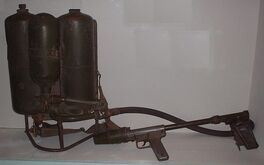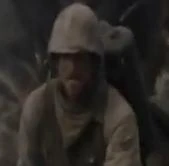
M2 Flamethrower
The M2 flamethrower (M2-2) was an American man-portable backpack flamethrower that was used in World War II. It was the successor to the M1 and M1A1 flamethrowers. Although its actual "burn time" was around 7 seconds and the flame was only effective out to around 33 meters it was still a functional weapon that had many uses in the war. However, with the later arrival of tanks and, especially, flamethrower tanks, the need for infantrymen to expose themselves to fire became unnecessary, as tanks offered greater protection and greater firepower
Though some M2s were sold off, the majority were scrapped when they were declared "obsolete."
Usage and history[]
Flamethrowers were first developed by the US Army Chemical Warfare Service in 1940-41. The early models were undependable and cumbersome. Testing continued and the M1 flamethrower was introduced into service in early 1942. This weapon was first used in combat by Marines of the 2nd Engineer Battalion on Guadalcanal in January 1943.The M1 used gasoline or a mixture of gasoline and diesel fuel and used hydrogen as its propellant. This caused too-rapid burning of the fuel, which was mostly consumed just beyond the nozzle and meant the operator had to approach to within 10-15 yards of the target. Another problem was that the flame tended to roll off the target.

Womack using the M2 Flamethrower.
Testing continued on improved delivery methods for flame weapons. In 1942, the Chemical Warfare Service developed a revolutionary concept–a thickening agent for gasoline. This agent, called napalm, improved the range, tightened the flame stream, and increased target effect. The M1 flamethrower was modified for use with napalm in 1942. The improved model was standardized as the M1-1. This weapon was used in the Pacific campaigns of 1943— early 1944. Though it was better then its predecessor, the M1-1 was still not a completely satisfactory weapon.
In late 1943, the 1st Marine Division received some M1-1 flamethrowers just prior to the New Britain campaign. The legendary Marine, LtCol Lewis "Chesty" Puller, observed a demonstration of the new flamethrower. Afterward, he asked, "Where do you put the bayonet on the damned thing?"
In the summer of 1944 the M2-2 flamethrower was introduced into service. This weapon was first used in combat on Guam and was subsequently employed in all Pacific campaigns. The M2-2 offered improved reliability and a better ignition system than previous models. It still had drawbacks–it was too heavy and had a high silhouette. This model used nitrogen as its propellant.
The Marine Corps realized the tactical value of the flamethrower. The D-series Marine division had 24 flamethrowers, all organic to the divisional engineer battalion. By 1944, the F-series division carried 243 flamethrowers into combat, spread throughout the division. Each Marine regiment was assigned 81 flamethrowers.
In combat, assault groups were formed with flamethrowers, demolition men and BAR men. They used a technique sometimes called "corkscrew and blowtorch" to destroy Japanese emplacements. Various methods were used in this tactic. BARs would suppress enemy positions with a heavy volume of automatic fire while the flamethrowers approached to within effective range. Then, flame was used to wipe out any pockets of enemy resistance.
After the enemy position was neutralized, demolition men would use explosive charges to destroy the emplacement, typically a cave mouth. Since flamethrower operators had to approach very close to enemy positions, effective suppressing fire by BARs and riflemen was critical. Flamethrower operators were extremely vulnerable to enemy fire since they effectively had a napalm bomb strapped to their back.
Known Users[]
"We kept up a steady fire into the pillbox to keep the Japanese pinned down while the flamethrower came up, carried by Corporal Womack from Mississippi. He was a brave, good-natured guy and popular with the troops. He was big and husky… [and] I was glad we were on the same side.
Stooped under the heavy tanks on his back, Womack approached the pillbox with his assistant just out of the line of our fire. When they got about 15 yards from the target, we ceased firing. The assistant reached up and turned a valve on the flamethrower. Womack then aimed the nozzle at the opening made by the 75mm gun. He pressed the trigger. With a whoooooosh the flame leaped at the opening. Some muffled screams, then all was quiet.…
Amid our shouts of appreciation, Womack and his buddy started back to battalion headquarters to await the summons to break a deadlock somewhere else on the battlefield–or lose their lives trying. The job of flamethrower gunner was probably the least desirable of any open to a Marine infantryman. Carrying tanks with about seventy pounds of flammable jellied gasoline through enemy fire over rugged terrain in hot weather to squirt flames into the mouth of a cave or pillbox was an assignment that few survived but all carried out with magnificant courage." - With the Old Breed at Peleliu and Okinawa
E. B. Sledge
"



